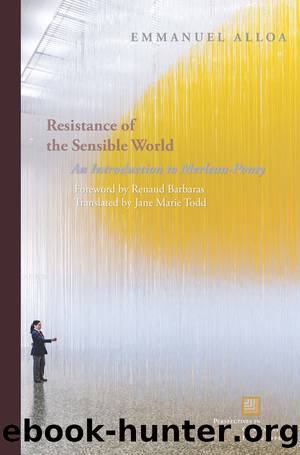Resistance of the Sensible World: An Introduction to Merleau-Ponty by Emmanuel Alloa

Author:Emmanuel Alloa [Alloa, Emmanuel]
Language: eng
Format: epub
Tags: Literary Criticism, Semiotics & Theory, Philosophy, History & Surveys, Modern, Movements, Phenomenology
ISBN: 9780823275670
Google: ANdFyQEACAAJ
Publisher: Fordham UP
Published: 2017-09-15T21:18:59+00:00
The Styles of the World
How, then, are we to understand what perception and expression have in common, while not resorting to a transcendental a priori? In fact, one path had already been indicated. In Phenomenology of Perception, no doubt under the influence of Husserl, Merleau-Ponty compares the unity of the world to the unity of style that can be recognized in a personâs behaviors or a cityâs familiar sites (PP, 378/342). Paradoxically, Merleau-Ponty seems to have rediscovered the pertinence of the notion of style on reading André Malrauxâs Voices of Silence, which makes it a key for understanding art, even as the book adheres to a rigorously classic semantics.8 In Malrauxâs eyes, style constitutes the artistâs signature, his mark, his stylus. In a passage from Voices of Silence, he says style is nothing other than âthe means of re-creating the world according to the values of the man who discovers itâ (quoted in SG, 83/53). As âa fragile human perspective of the eternal world which draws us along according to a mysterious rhythm into a drift of starsâ (SG, 83/53), style in Malrauxâs view reiterates the rift between natural world and human world. It cannot fail to open onto a consideration of modern artâwhere style is at once the imperative and the unique, undisputed beliefâas a ceremony glorifying the individual. If, as a passage from The Creative Act, the second volume of Malrauxâs Psychology of Art,9 has it, style is âthe expression of a meaning lent to the world, a call for and not a consequence of a way of seeingâ (SG, 83/53), then there is every reason to speak of an âannexation of the world by the individualâ (ibid., trans. modified).
According to Merleau-Ponty, however, style is not produced by a subjectivity: It is a feature of the world as it manifests itself. Far from being confined to the realm of art, style is what in-forms the world; it is the guarantee that a world is never given once and for all but is constantly modulated, articulated, rhythmicized. âPerception already stylizes,â Merleau-Ponty claims in a famous passage from The Prose of the World (PM, 83/59), thereby obliterating the dichotomy between receptivity and activity. It is the correlation itself that undergoes a certain inflection, and that correlation does not precede the dichotomy between receptivity and activity but constitutes its nexus. Husserl may have already glimpsed as much in the manuscripts of Ideen II (PM, 79/56), where the notion of style is not limited to the permanent, unitary style (einen gewissen durchgängigen einheitlichen Stil) of a personality in its judgments and acts. There is also what could be called habitus or overall style (Gesamtstil), a concordant unity that characterizes all the activities (and passivities) of a subject.10 In The Crisis of European Sciences, Husserl will go even further. Style is now characteristic not of an ego but of the world itself: âThus our empirically intuited surrounding world has an empirical over-all style [empirischen Gesamtstil].â11 For the later Husserl, it is in the
Download
This site does not store any files on its server. We only index and link to content provided by other sites. Please contact the content providers to delete copyright contents if any and email us, we'll remove relevant links or contents immediately.
| Deconstruction | Existentialism |
| Humanism | Phenomenology |
| Pragmatism | Rationalism |
| Structuralism | Transcendentalism |
| Utilitarianism |
The remains of the day by Kazuo Ishiguro(8815)
Tools of Titans by Timothy Ferriss(8212)
Giovanni's Room by James Baldwin(7188)
The Black Swan by Nassim Nicholas Taleb(7009)
Inner Engineering: A Yogi's Guide to Joy by Sadhguru(6722)
The Way of Zen by Alan W. Watts(6504)
Asking the Right Questions: A Guide to Critical Thinking by M. Neil Browne & Stuart M. Keeley(5630)
The Power of Now: A Guide to Spiritual Enlightenment by Eckhart Tolle(5603)
The Six Wives Of Henry VIII (WOMEN IN HISTORY) by Fraser Antonia(5394)
Astrophysics for People in a Hurry by Neil DeGrasse Tyson(5130)
Housekeeping by Marilynne Robinson(4328)
12 Rules for Life by Jordan B. Peterson(4249)
Double Down (Diary of a Wimpy Kid Book 11) by Jeff Kinney(4204)
The Ethical Slut by Janet W. Hardy(4172)
Skin in the Game by Nassim Nicholas Taleb(4161)
Ikigai by Héctor García & Francesc Miralles(4123)
The Art of Happiness by The Dalai Lama(4063)
Skin in the Game: Hidden Asymmetries in Daily Life by Nassim Nicholas Taleb(3929)
Walking by Henry David Thoreau(3892)
